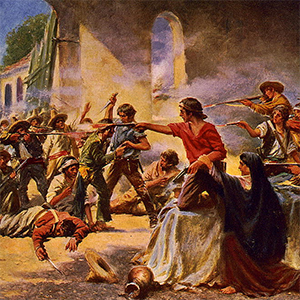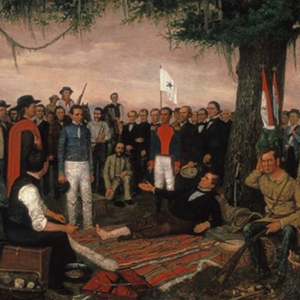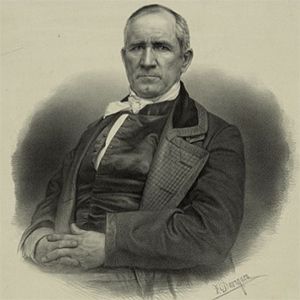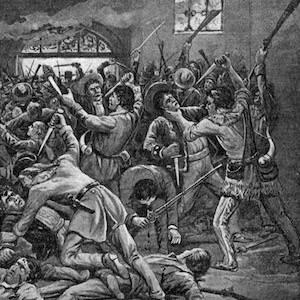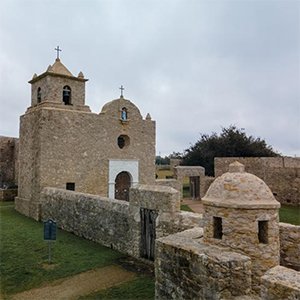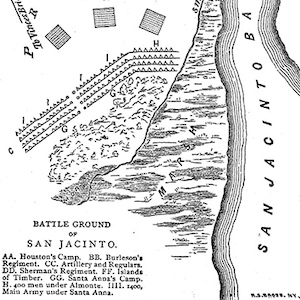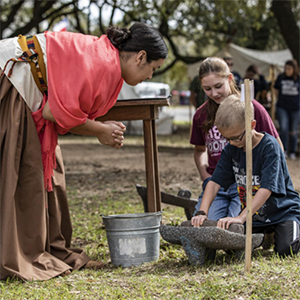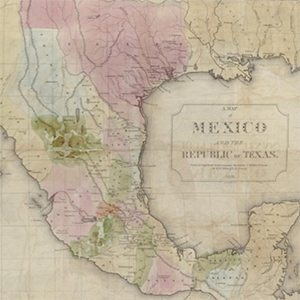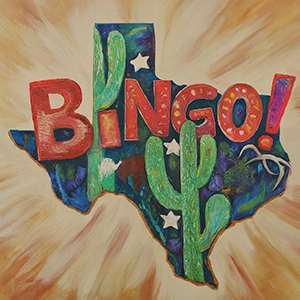This one-day lesson examines the significant themes and defining characteristics of the Texas Revolutionary Era.
THIS UNIT
Browse unit contents using the tabs to the right or the filters below.
Share
Tell other teachers, parents, and students about us.
Follow
Pacing
This unit is a three-week study of the events of the Texas Revolution. Suggested pacing minutes are based on the average time it takes a class to complete each lesson; however, as the educator, use your best judgment based on the average pace of your class learning styles.
Contents
Era Overview
Conflicts during the Texas Revolution Period brought tremendous chaos and upheaval to nearly everyone within Texas. Public opinion throughout Texas during the Revolution was deeply divided. Some Anglo-American settlers feared the destruction that a war could bring to the region, while others (often newer arrivals) sought to break the region from Mexico. Most Tejanos saw the conflict as part of a larger civil war within Mexico that pitted Santa Anna’s centralists against the federalists who wanted to restore the Constitution of 1824. For some enslaved African Americans, the war offered a chance to gain their freedom by running to the lines of the Mexican Army. Women in Texas often had to fend for themselves and their children when men left to fight on the frontlines.
When fighting broke out in October 1835, most Texans could not yet agree on whether they were fighting to restore the Constitution of 1824 or for independence. When Santa Anna marched his army into Texas in February 1836 and laid siege to the Alamo, a delegation of Texans responded by declaring independence on March 2, 1836. The war itself brought widespread destruction to the region, with the fall of the Alamo, the massacre at Goliad, the panic of the Runaway Scrape, and the burning of towns and homes by both armies. When Sam Houston’s ragtag army won an improbable victory at San Jacinto on April 21, 1836, the results of the Texas Revolution reverberated across all of North America.
Unit Level Downloads (English)
-
Downloadable/Editable versions of the English language unit plan. Provides an Era Overview and pacing, and outlines each lesson’s estimated completion time, essential questions, a description of each lesson, and student learning experiences and activities.
-
Archived Materials
A downloadable zip file containing the previous verion of this unit’s lesson materials (available on this site c. 2022-2024).
Other Units
Lessons
Most lessons contain downloadable and printable documents, activities, and other resources to aid in classroom instruction. Lesson materials are available in multiple formats and typically contain variations based on learning needs.
The Big Picture
How Do We Know What We Know?
In this one-day lesson, students analyze three primary source materials from the Texas Revolution to make observations and inferences about significant people and events of the era.
Vocabulary
This two-day lesson presents unit vocabulary in short readings that provide the terms in the context of significant information from the unit. Students use the readings to complete vocabulary charts and take a vocabulary quiz.
What's the Story?
In this one- or two-day lesson, students learn about the most significant events of the Texas Revolution through a series of eight short readings.
Who’s Who of the Texas Revolution
This lesson provides readings, worksheets, and additional extension activities for researching key people of the Texas Revolution and their significance to the era.
Events of the Revolution - Guided Notes
A three-day lesson presenting key information including dates, locations, details, and significance of the key events of the Texas Revolution.
The Battle of the Alamo Extension Activity
This one- or two-day optional extension activity allows students to learn about the day-by-day events of the siege and battle of the Alamo. Students identify the location of key events on a map of the Alamo complex and create a written or visual representation of the events.
The Texas Declaration of Independence Extension Activity
In this optional one-day extension lesson, students analyze excerpts of the Texas Declaration of Independence to identify key topics, major themes, and the primary grievances of the Texans. Students compare the Texas Declaration of Independence with a portion of its American counterpart.
The Goliad Massacre Extension Activity
In this optional one-day extension lesson, students watch a short Texas History for Teachers documentary about the Goliad Massacre and record significant information about the event.
The Battle of San Jacinto Extension Activity
This optional one-day extension lesson examines the causes, key events, and effects of the Battle of San Jacinto through a 14-minute documentary video presented by Texas History for Teachers.
Texas Today
In this one-day lesson, students use the Texas Historical Commission website to conduct online research about one Texas Revolution state historic site and plan the itinerary for a class field trip to their chosen site. This lesson reviews TEKS-based material presented in prior lessons but does not introduce new TEKS-related material.
Looking Ahead
A one-day lesson that presents a preview of four significant challenges the Republic of Texas faced in 1836 and the possibility of Texas annexation to the United States as a way of addressing these issues.
Study Guide and Flashcards
This one-day lesson provides a variety of ways for students to review significant information about the Texas Revolution including matching, cause-and-effect, creating a timeline, and answer practice test questions based on 8th grade STAAR item types.
Review Mind Map
An optional, one-day review lesson providing students an opportunity to make connections between key terms, people, places, and major themes within the unit by creating a mind map.
Review Bingo Game
An optional, one-day review game in which students play Bingo to review key terms, people, places, events, and major themes of the Texas Revolution.
Maps
We've assembled the following list of maps that are applicable to the Texas Revolution Unit.
North America
A map of the North American continent. The map is color coordinated by countries and territories circa 1836.
New map of Texas: with the contiguous American & Mexican states (1836)
"Entered according to Act of Congress in the year 1835." Insets: Land grants, Remarks on Texas, Rivers of Texas.
Map of Texas with parts of the adjoining states. (1836)
Map shows early land grants and colonies in Texas and New Mexico encompassing [modern-day] Texas panhandle; areas of Native American habitation, land grant boundaries. Includes notes. Relief shown by hachures. Scale [ca.1:1,500,000].
Military Maps of the Texas revolution - San Antonio de Bexar - 1836
Map of San Antonio de Bexar showing the streets, rivers and creeks, and plazas as they were in 1836.
Military Maps of the Texas revolution - Combat near the Mission Concepción, October 28, 1835.
Map of combat at the Battle of Concepción during the Texas Revolution, showing lines of assault by Mexican infantry, cannon, and dragoons, and lines held by Captain Fannin's and Captain Coleman's companies. The battlefield is surrounded by wooded terrain and lies next to the San Antonio River. No scale indicated.
Military Maps of the Texas revolution - The siege of Bexar
Hand-drawn map depicting the Siege of Bexar. It shows the line of attack by the Texans against the Mexican forces occupying Bexar and supported by the Mexican garrison then in the Alamo, from December 5th to 10th, 1835. Map including roads, major buildings, rivers, and creeks. The distances to various locations are given. Some twentieth century streets of San Antonio are superimposed. No scale indicated.
Military Maps of the Texas revolution - Refugio Mission
"Ground plan of the original buildings, with walls enclosing the cemetery"
Military Maps of the Texas revolution - Ground plan of Fort Defiance
"Relief shown by hachures. "To accompany Texas independence by Col. A.J. Houston."
Military Maps of the Texas revolution - Map of Texas, with Coahuila, in 1835-36
Map of the United States and Mexico, showing territories but not states. Cities and towns representing areas of recruitment are shown, as are Indian villages and forts in Texas. No scale indicated.
Military Maps of the Texas revolution - Military map of Texas and Coahuila, as Mexican territory, 1835-36
Military map of Texas and Coahuila, showing lines of Mexican and Texan frontier and lines of march to the San Jacinto battlefield during the Texas Revolution. The map also includes rivers, creeks, towns, routes, trails, mines, and Indian villages. No scale indicated.
Military Maps of the Texas revolution - The Alamo
Ground plan compiled from drawings by Capt. B. Green Jameson, Texan Army, January, 1826,Col. Ignacio de Labastida, Mexican Army, March, 1836, Capt. Ruben M. Potter, United States Army, 1841.
Military Maps of the Texas revolution - Fannin's fight
Map of Fannin's Fight, showing the Texas Infantry, breastworks, and lines of assault by Mexican Dragoons and Infantry. Lines of march used by Colonel Fannin and General Urrea are also shown. Note: " [shows] rise of six feet, behind which Mexican Artillery fired, on the 20th." There are also notes on the type of cannons used. Distances to various cities are given. No scale indicated.
Military Maps of the Texas revolution - Map of the battlefield of San Jacinto
Map of the Battlefield of San Jacinto and map of the positions of the Texan and of the Mexican Armies, at the commencement of the Battle of San Jacinto, at half past three o'clock in the afternoon of Thursday, April 21, 1836. Shows the positions of the armies and features of the terrain between Buffalo Bayou and San Jacinto Bay.
Videos
We provide videos for both continuing education and classroom use. Please see each video's descriptive page for related resources and details about accessibility and viewing options.
Preview of the Texas Revolution
A short introductory video to the Texas Revolution Unit. Includes worksheets and/or other attachments.
American Indians in the Texas Revolution
Discusses the viewpoints of American Indians during the Texas Revolution, as both the Mexican and the Tejano sides of the conflict sought the support of Texas tribes. Includes worksheets and/or other attachments.
Women of the Texas Revolution
Discusses the viewpoints of women who bore witness to the Texas Revolution. Includes worksheets and/or other attachments.
Who was Joe?
Introduces students to Joe, the enslaved man owned by William Barret Travis during the Texas Revolution. Includes worksheets and/or other attachments.
Who was Juan Seguín?
Introduces students to Juan Seguín, a Mexican-born citizen who supported Texas’ right to influence Mexican law, and fought for Texas Independence. Includes worksheets and/or other attachments.
Who was Susanna Dickinson?
Introduces students to Susanna Dickinson, who survived the Alamo siege and relayed a message to General Sam Houston. Includes worksheets and/or other attachments.
Road to Revolution
The factors leading to revolution in Texas, covering: A Ridiculous Rebellion in East Texas, Constitution of 1827, Decree 56, Thwarting Mexican Law, Law of April 6, 1830.
Rebellion
The factors leading to revolution in Texas, covering: Disturbances at Anahuac and Velasco, Texans as Ardent Federalists, The Quest for Separate Statehood, Cotton Boom!, Chaos of 1835, Revolution Begins.
Revolution (Part 1)
The Texas Revolution, covering: Chaos of Late 1835, Battle of San Antonio.
Revolution (Part 2)
The Texas Revolution (continued from part 1), covering: Siege of the Alamo.
Revolution (Part 3)
The Texas Revolution (continued from part 2), covering: Aftermath of the Siege of the Alamo, Massacre at Goliad, Runaway Scrape, San Jacinto.
Tours
This section contains various kinds of multimedia resources that are meant to engage the student through virtual exploration and active engagement. Items may contain Video Tours, Virtual Field Trips, Timelines, Maps, and other media. Please Note: some features are experimental, work best on a large, or full screen. Most items contain visually rich media with movement, and some items require physical manipulation of items on the screen with a mouse or touch device.
Goliad: Virtual Field Trip
Explore an iconic setting of Texas history with an immersive journey through video, 3D virtual environments, photos, and documents of the Presidio La Bahia, also known as Fort Defiance, as well as Fannin Battleground State Historic Site in and around Goliad, TX.
The Battle of San Jacinto
Dr. Andrew Torget shares facts and stories from a seminal event in Texas history - the Battle of San Jacinto.
More Resources
The following list of resources provide additional information to help you dive deeper into the context of the unit. Books are linked to OCLC WorldCat, allowing you find a copy in your nearest local library or to make a request for it using interlibrary loan.
Supplemental Files
image Token Sticker Sheet
General
website Results for The Texas Revolution, 1835-1836 in The Portal to Texas History
website The Handbook of Texas
book Todd Hansen, ed., The Alamo Reader: A Study in History (Stackpole Books, 2003)
Tejanos In The Revolution
book Andrés Tijerina, Tejanos and Texas Under the Mexican Flag, 1821-1836 (Texas A&M Press, 1994).
Women In The Revolution
book Mary L. Scheer, ed., Women and the Texas Revolution (University of North Texas Press, 2012).
book Todd Hansen, ed., The Alamo Reader: A Study in History (Stackpole Books, 2003)
African Americans In The Texas, 1821-1836
book Paul Lack, “Black Texans and Slavery in Revolution and War,” in The Texas Revolutionary Experience.

